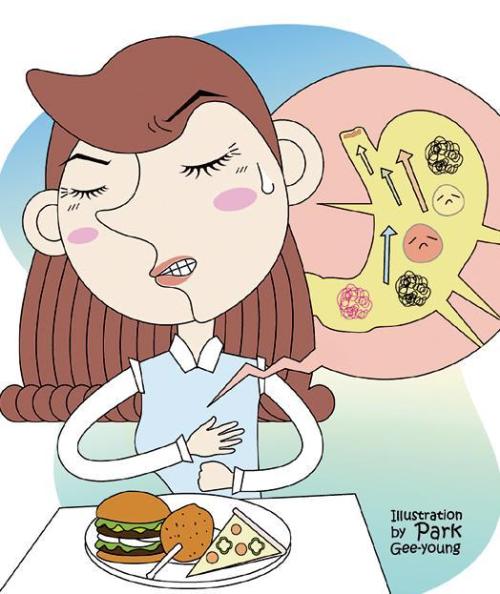Gastroesophageal reflux disease, or GERD, is a common chronic digestive disease that occurs when stomach contents such as acid or, occasionally, bile refluxes into the esophagus.

The backwash of acid irritates the lining of the esophagus and causes various GERD signs and symptoms.
Typical symptoms include acid reflux and heartburn. Acid reflux is a regurgitation of sour liquid into your mouth, and heartburn is a burning sensation in your chest, sometimes spreading to the throat.
Most people experience these symptoms from time to time. But if they occur more than twice a week or affect your daily life, doctors diagnose them as GERD.
Along with these common symptoms, the patient also can experience chest pain, sensation of a lump in the throat, dry cough, hoarseness, or difficulty swallowing.
When you swallow, the lower esophageal sphincter (a circular band of muscle around the bottom part of your esophagus) relaxes to allow food and liquid to flow down into your stomach. Then it closes again.
However, if this valve relaxes abnormally or weakens, stomach acid can flow back up into your esophagus, causing frequent heartburn and disrupting your daily life. This constant backwash of acid can irritate the lining of your esophagus, causing inflammation called esophagitis.
Over time, chronic inflammation in your esophagus can lead to complications, including narrowing of the esophagus (esophageal stricture), which causes swallowing difficulty; an open sore in the esophagus (esophageal ulcer); and precancerous changes to the esophagus (Barrett’s esophagus).
Barrett’s esophagus is associated with an increased risk of esophageal cancer. Even though the risk of cancer is low, your doctor will recommend regular endoscopy exams to look for early warning signs of esophageal cancer.

Conditions that can increase your risk of GERD include obesity, hiatal hernia, pregnancy, smoking, dry mouth, asthma, diabetes, delayed gastric emptying, connective tissue disorders such as scleroderma, and Zollinger-Ellison syndrome.
If you’re bothered by frequent heartburn or other signs and symptoms, your doctor may be able to diagnose GERD with that information alone.
Your doctor may also suggest tests and procedures. Endoscopy allows a doctor to examine the esophagus and stomach. An ambulatory acid (pH) test uses a device to measure the amount of acid in your esophagus. There is also a test to measure the movement of the esophagus.
Most GERD can be controlled with medication.
For treatment for heartburn and other signs and symptoms of GERD, your doctor may prescribe medications, such as H-2-receptor blockers including cimetidine (Tagamet), famotidine (Pepcid), nizatidine (Axid) and ranitidine (Zantac), or proton pump inhibitors, including esomeprazole (Nexium), lansoprazole (Lanston), omeprazole (Losec), pantoprazole (Pantoloc) and rabeprazole (Pariet).
Lifestyle changes also greatly help decrease the frequency of heartburn and following are some tips:
Try to maintain healthy weight; avoid tight-fitting clothing; avoid eating foods that trigger heartburn such as fatty or fried foods, alcohol, chocolate, mint, garlic, onion and caffeine; do not lie down right after having a meal ― at least two to three hours are needed; place wood or cement blocks under the head of your bed to elevate it about six to nine inches; and quit smoking.
By Rhee Poong-lyul, M.D., Ph.D.
The writer is professor of gastroenterology at Sungkyungkwan University School of Medicine, Samsung Medical Center. ― Ed.

The backwash of acid irritates the lining of the esophagus and causes various GERD signs and symptoms.
Typical symptoms include acid reflux and heartburn. Acid reflux is a regurgitation of sour liquid into your mouth, and heartburn is a burning sensation in your chest, sometimes spreading to the throat.
Most people experience these symptoms from time to time. But if they occur more than twice a week or affect your daily life, doctors diagnose them as GERD.
Along with these common symptoms, the patient also can experience chest pain, sensation of a lump in the throat, dry cough, hoarseness, or difficulty swallowing.
When you swallow, the lower esophageal sphincter (a circular band of muscle around the bottom part of your esophagus) relaxes to allow food and liquid to flow down into your stomach. Then it closes again.
However, if this valve relaxes abnormally or weakens, stomach acid can flow back up into your esophagus, causing frequent heartburn and disrupting your daily life. This constant backwash of acid can irritate the lining of your esophagus, causing inflammation called esophagitis.
Over time, chronic inflammation in your esophagus can lead to complications, including narrowing of the esophagus (esophageal stricture), which causes swallowing difficulty; an open sore in the esophagus (esophageal ulcer); and precancerous changes to the esophagus (Barrett’s esophagus).
Barrett’s esophagus is associated with an increased risk of esophageal cancer. Even though the risk of cancer is low, your doctor will recommend regular endoscopy exams to look for early warning signs of esophageal cancer.

Conditions that can increase your risk of GERD include obesity, hiatal hernia, pregnancy, smoking, dry mouth, asthma, diabetes, delayed gastric emptying, connective tissue disorders such as scleroderma, and Zollinger-Ellison syndrome.
If you’re bothered by frequent heartburn or other signs and symptoms, your doctor may be able to diagnose GERD with that information alone.
Your doctor may also suggest tests and procedures. Endoscopy allows a doctor to examine the esophagus and stomach. An ambulatory acid (pH) test uses a device to measure the amount of acid in your esophagus. There is also a test to measure the movement of the esophagus.
Most GERD can be controlled with medication.
For treatment for heartburn and other signs and symptoms of GERD, your doctor may prescribe medications, such as H-2-receptor blockers including cimetidine (Tagamet), famotidine (Pepcid), nizatidine (Axid) and ranitidine (Zantac), or proton pump inhibitors, including esomeprazole (Nexium), lansoprazole (Lanston), omeprazole (Losec), pantoprazole (Pantoloc) and rabeprazole (Pariet).
Lifestyle changes also greatly help decrease the frequency of heartburn and following are some tips:
Try to maintain healthy weight; avoid tight-fitting clothing; avoid eating foods that trigger heartburn such as fatty or fried foods, alcohol, chocolate, mint, garlic, onion and caffeine; do not lie down right after having a meal ― at least two to three hours are needed; place wood or cement blocks under the head of your bed to elevate it about six to nine inches; and quit smoking.
By Rhee Poong-lyul, M.D., Ph.D.
The writer is professor of gastroenterology at Sungkyungkwan University School of Medicine, Samsung Medical Center. ― Ed.








![[Graphic News] More Koreans say they plan long-distance trips this year](http://res.heraldm.com/phpwas/restmb_idxmake.php?idx=644&simg=/content/image/2024/04/17/20240417050828_0.gif&u=)
![[KH Explains] Hyundai's full hybrid edge to pay off amid slow transition to pure EVs](http://res.heraldm.com/phpwas/restmb_idxmake.php?idx=644&simg=/content/image/2024/04/18/20240418050645_0.jpg&u=20240419100350)







![[KH Explains] Hyundai's full hybrid edge to pay off amid slow transition to pure EVs](http://res.heraldm.com/phpwas/restmb_idxmake.php?idx=652&simg=/content/image/2024/04/18/20240418050645_0.jpg&u=20240419100350)

![[Today’s K-pop] Illit drops debut single remix](http://res.heraldm.com/phpwas/restmb_idxmake.php?idx=642&simg=/content/image/2024/04/19/20240419050612_0.jpg&u=)